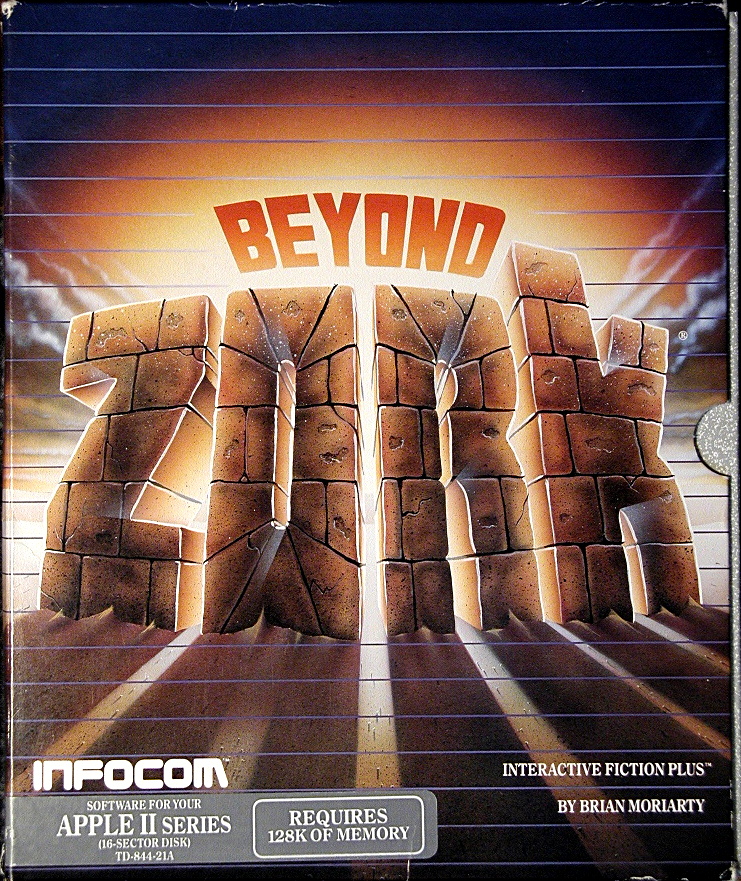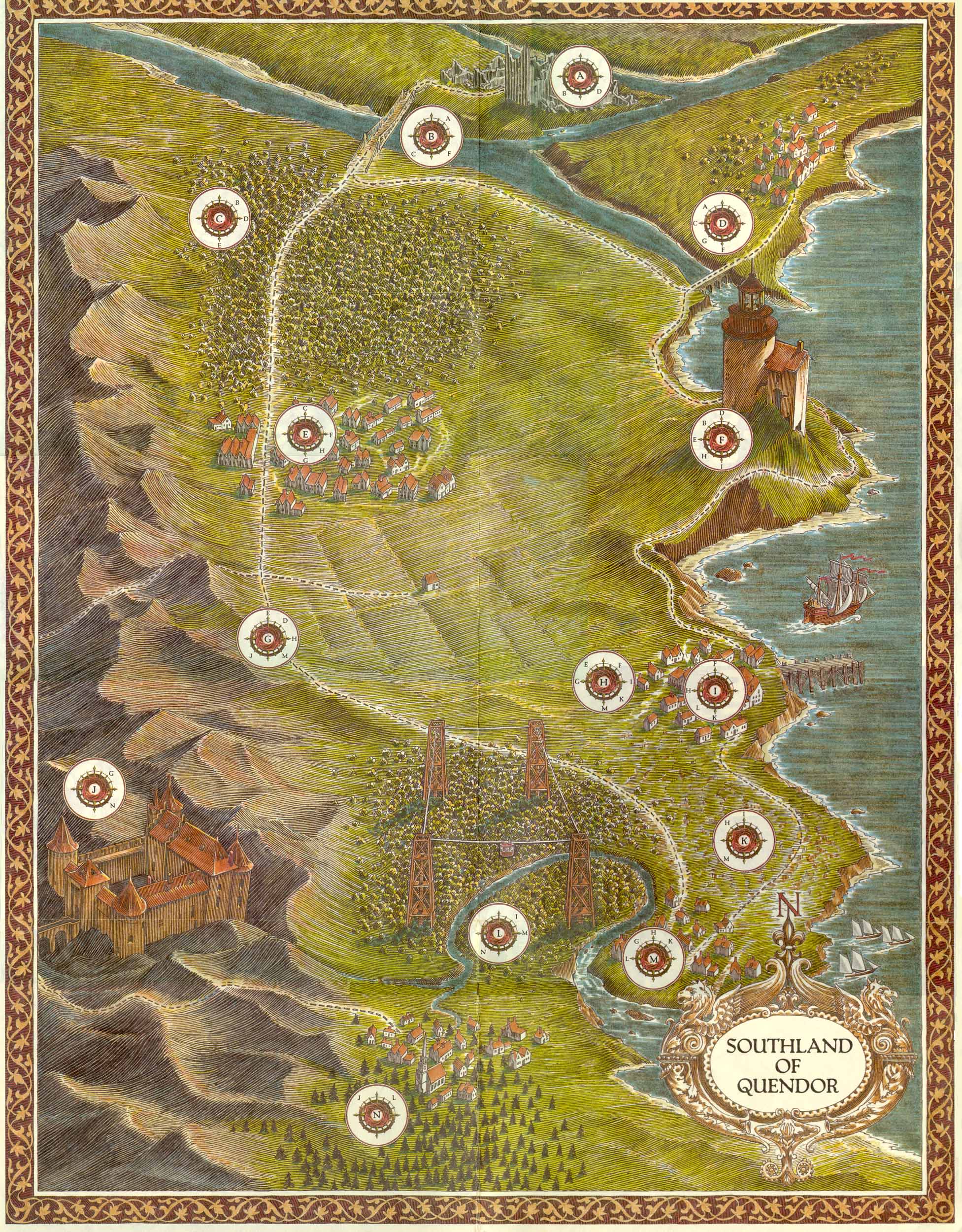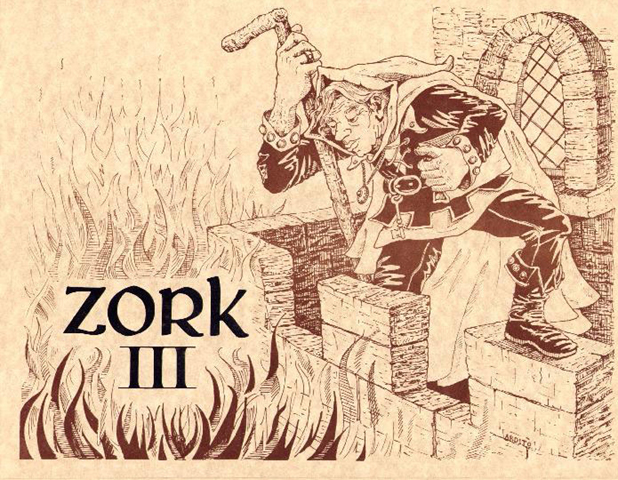IFDB page: Spellbreaker
[This review contains many major spoilers for Spellbreaker and some mild to moderate spoilers for Zork and Enchanter series games. Also, I wrote an introduction to these Infocom >RESTART reviews, for those who want some context.]
When I first started listening to the Beatles as a kid, I listened to the hits, and to me they were all just Beatles songs. Before too long, I could feel the differences between the early stuff (i.e. the red album) and the later stuff (the blue album.) From there I moved away from hits collections into regular releases, and my ears began to pick up the Paul songs, versus the John songs, versus the George songs, versus the Ringo songs. Sufficient listening, reading, and attention got me to the point of fine discernment, understanding the subtle but unmistakable differences between Rubber Soul Paul vs. Revolver Paul, or between Let It Be George and Abbey Road George.
Where am I going with this? The voices within Infocom, pretty clearly the Beatles of interactive fiction, reveal themselves similarly given sufficient attention. At first they all feel like just Infocom games, but we can start to pick out the styles after a while. There’s the brash, prolific, and eclectic Meretzky, the cerebral Blank, the ambitious and enthusiastic Moriarty, and so on. Spellbreaker belongs indelibly to the voice of Dave Lebling, possibly the finest writer of the lot, and a creator who lovingly balanced sober themes with dry humor, biting understatement with mathematical intricacy. Not only that, this is classic mid-period Lebling, a flowering of IF’s potential before the chillier days of commercial retrenchment set in.
>EXAMINE WRITING AND STRUCTURE
Spellbreaker was one of my favorite Infocom games when I was playing them in the ’80s, and I was particularly excited to share it with Dante. Looking at the game now, I think it holds up quite well, though I do have some critiques here and there. In particular, Lebling’s writing really shines. Just in the introduction alone, there are so many artful touches. For instance, when Sneffle of the Guild of Bakers complains about the gradual failing of magic:
>examine sneffle
Sneffle is a small doughy gentleman whose person is splotched here and there with flour.
“Doughy” is a rich word to describe a person, and using it for the baker, without piling on the puns, evokes a strong visual, especially combined with his comical flour-splotches. Then there’s the subtle evocation of Shakespeare when: “In the blink of an eye there stands at the podium, not the orator, but rather a large orange newt.” Eye of newt indeed, and something wicked this way comes.
This game also has some of Infocom’s most vivid imagery, and memories of playing it as a teen have stuck with me strongly through the years. In particular, the “beautiful blue carpet with a strange design of cubes” is something I’ve always wished would manifest in this world. I would buy it in a snap. (Though I’d probably want to haggle the price.) Etsy carpet-weavers, make me an offer. Here’s your product description:
>examine blue carpet
This is a carpet of unusual design. It is blue, beautifully woven and has a pattern that looks different each time you look at it. Sometimes, for example, it's an array of cubes pointing upward, and other times it's the same array pointing downward. There is a jaunty fringe around the outer edge.
In Spellbreaker, which by certain lights is Zork VI, Lebling finds himself in the position of finishing a second trilogy, and tonally he makes some similar choices to what Zork III did. Not that this game is anywhere near as bleak and radical as Zork III was, but it shares a similar feeling of somber grandeur. The ruins and the abandoned castle, in particular, give the same sense of desolation. The Ouroboros snake and the rat-idol, like the Royal Puzzle and the Technology Museum, are once-important landmarks left mouldering and forgotten.
Compared to the “fight the Big Bad” plots of the previous two Enchanter-series installments, this a darker and more adult finale, with richer textures and deeper pleasures than the other two. I’ll have more to say about the plot-level comparison with Zork III when I discuss the endgame, but for now I’ll leave it with the observation that the notion of magic slowly failing is a wonderful metaphor for coming of age, and this game moves IF from innocence to experience in a beautiful and gentle way, which encompasses the seriousness of Zork III but leaves much more room for playfulness than that finale did.
Much of the fun in an Enchanter-ish game is the way that you can use your magic to make changes to yourself and the world around you, and Spellbreaker is no exception. Usually, when an IF game wants to surprise and delight, the author needs to anticipate actions that the player wouldn’t expect to see implemented, and give some fun response to those actions. However, Spellbreaker (and the Enchanter series broadly) gets mileage out of a different technique, which is to allow harmless alterations of the world that enrich the player’s experience without requiring any foresight on the part of the author.
One example of this is how you can frotz various things — the loaf of bread, the roc, et cetera — to make a lantern out of some unassuming object or imagine a puzzle component glowing uncharacteristically. This sort of pleasure was available in previous games, but Lebling adds another layer in Spellbreaker — the ability to label objects with arbitrary names, injecting your own sense of order or humor into the game’s world. Beyond Zork copied this quality but with less success, because (aside from the convenience factor of not having to type out “pterodactyl” all the time) its use was totally superfluous to the game.
Spellbreaker, by contrast, gives us a load of identical items — the cubes — which must be distinguished from each other in order to accomplish a successful playthrough. The ability to label these cubes in whatever way makes the most sense (or seems the most fun) to the player allows us to inject our own personalities into the game’s world. It’s such a pleasure that the Invisiclues even included a section titled “What did we name the cubes here at Infocom?”
Structurally, too, the game feels mature. Rather than a big, sprawling dungeon (like the Zork trilogy games) or a compact trunk full of puzzles (like Enchanter and, to a lesser extent, Sorcerer), Spellbreaker incorporates many dimensions and many sub-maps, which sometimes link into larger maps. Lebling themes these dimensions around fundamental elements, forces, and concepts, allowing players to feel that their travels are not only traversing a map but encompassing, via metaphor, the full universe of the game. Each new discovery not only expands the world but enriches it as well — rather like the mapping version of how the spell mechanic deepened the Zork game model. The ability to travel via cube gives us new angles on previously visited locations, as well as new locations, just as the ability to cast spells gave us new angles on puzzle-solving, along with all the old ones that were still available to us.
>COMPARE SPELLBREAKER TO D&D
One of those spells, “snavig”, proves particularly entertaining. This spell allows the PC to transform into any nearby creature, which not only underpins several puzzles but is also an imaginative delight. In particular, Spellbreaker breaks the trend of grue avoidance and lets us become a grue at last! This in turn enables one of the most fun Easter eggs in the game:
>snavig grue
You feel yourself changing in a very unpleasant way. Your claws feel odd, and you have an uncontrollable tendency to slaver. You gurgle vilely to yourself, worrying about the presence of light. Directly in front of you, a horrific creature recoils with a look of shocked surprise. It scuttles off, perplexed.
>slaver
You do that very well for such an inexperienced grue.
It’s fitting that Lebling, the inventor of the grue (for IF purposes), got to flesh them out with such panache here. Spellbreaker would be Lebling’s last grue-infested game.
“Snavig” feels indebted to the “polymorph” spell from Dungeons and Dragons, and it’s one of a few clear D&D tributes in this game. I’ve written before about IF’s connections to the classic tabletop RPG, and it’s worth mentioning again that Dave Lebling was a member of Will Crowther’s D&D group, which influenced Crowther’s genre-founding cave-exploration simulator. Besides polymorphing, the game strikes another D&D note when it lets you pry a gem out of the eye of a giant idol, a clear homage to the classic painting on the cover of the first edition Player’s Handbook.
The game’s biggest and best D&D tribute, though, is the magic zipper — a Bag of Holding in all but name. Just as frotz removed light source puzzles and rezrov removed locked door puzzles, so does the magic zipper remove inventory limit “puzzles” by allowing the player to carry a functionally infinite number of items. (How I wish it had been in Beyond Zork!) And just as these games found ways to create light and lock puzzles despite frotz and rezrov, this game finds a way to make the removal of inventory limits a detriment to the player, by including a puzzle that requires an inventory object to be sitting on the ground.
>ANALYZE PUZZLES
This puzzle — the gold box — has a great concept, but in practice it’s just underclued. In case it’s been a while: each cube has an exit that seems impassable, but it turns out that it really goes to wherever the gold box is if the gold box is keyed to that cube. However, because it’s counterintuitive adventurer behavior to not carry around everything you can, Dante and I never had occasion to find this out without turning to the hints, despite the fact that we knew the gold box was important and we understood it could be tuned to different cubes. The puzzle feels reminiscent of those puzzles in Zork II and Enchanter where you need to not have a light source.
However, those light source puzzles were hinted at — perhaps obliquely (especially in the case of Zork II), but hinted nonetheless. No such luck in Spellbreaker, and consequently it stumped us. Maybe if the opened “impassable” exit felt a little less rigid, even when you’re holding the box? Or if the phrasing when trying to put anything other than a cube in the box was a parallel to trying to go through the impassable exit? There needs to be something more to link the box to what it does — otherwise it’s hard to imagine many people actually figuring this out rather than stumbling upon it by flailing blindly. Perhaps I’m overstepping in that speculation, but it was certainly the case for us. Ironically, an inventory limit might have helped here, but what would have helped much more is better cueing.
The gold box puzzle is one of a few places where it felt like the game was trying to live up to its “Expert” difficulty rating. The last third (or so) of Spellbreaker has several puzzles which require quite a bit of patience — the octagonal rooms, the flat plain, and worst of all the cube piles. As you can probably tell from that summary, Dante and I found them a mixed bag. There was a certain elegance and satisfaction to the first two, but we face-planted completely on the last one. According to the Invisiclues, those cube piles are “a variation of a classic coin-weighing puzzle” — one coin may be heavier or lighter than 11 identical others, and you have to figure out which with only three weighings — but we never did solve it. We just got through it with dumb luck (and a lot of save and restore). None of these math/mapping/logic puzzles were as enjoyable for us to play through as the first two-thirds of the game, but that may be mainly a matter of taste. Except for the coin puzzle, at which I shake my fist one last time.
>WHAT IS MAGIC?
As I’ve mentioned, the cubes tie the game together and thematically traverse numerous fundamental concepts. As you progress through the game, you move from exploring the classical world of material elements — fire, earth, air, water — into an immaterial realm of concepts — connectivity, time, mind, life, death. Further, while the classical elements may make up our world, some of those more conceptual elements underpin the virtual world of the game. Connectivity suggests pointers in code, and the “No Place” of the mind cube is like a null pointer, or a null value. Connections between nodes run underneath the game at the code level, and within the game at the map level, not to mention that the title “String Room” is itself a string within the game’s code, along with every other snippet of language it contains. The binary oppositions (light/dark, life/death) evoke the ones and zeroes underneath it all.
Finally, there is magic, which is what happens when creatures like us from the material world use life and mind over time to interact with the virtual environment. Immersion is the closest we get to magic, and Spellbreaker is a masterfully immersive game — Dante and I made the fewest notes of any Infocom playthrough, because we found the experience so involving.
But startlingly, our final aim (it emerges) is to eliminate magic. There’s another interesting parallel with Zork III here. In that game, you become the owner of creation, by gathering the elements that distinguish its ownership. Here, you become responsible for creation by gathering the elements that define its existence, and what you must protect it from is yourself, or at least the worst version of you. Then, rather than safeguarding a dungeon of wonders, you must create a universe of mundanity.
The notion of a literal, magical shadow self echoes Zork III once again, wherein you must strike your shadow self down with a magical sword, then show compassion to it. Here, rather than a mystical test imposed by a godlike figure, your shadow is the result of magic itself, an “evil twin” that grows in power every time you cast a spell. Thus, if you eliminate the magic, you eliminate the evil.
It’s a nice thought, and Spellbreaker sells it skillfully, but it’s pretty problematic on inspection. The magical shadow only literalizes a truth — that the exercise of power is itself a creator of potential corruption. In 2022 it is painfully evident that even in a world without magic, we must regularly contend with humans controlled by their shadow sides in their desire to obtain and retain power. If only we could so simply remove the element of our existence that creates this quality, but we would have to remove ourselves. The problem isn’t magic — it’s humans.
There’s a less allegorical way to interpret this, though. In the end, what your shadow does is to create — implement — a universe. Your job is to remove the magic from the center of that universe. (We replaced it with a chunk of rye bread (providing light), a slyly still-a-little-bit-magical keystone.) The idea of turning a miraculous universe into an ordinary one (replacing mages with scientists) feels on one level like a counterintuitive, anti-creative notion. But it is an intriguing one for a magical world running on a scientific platform.
Also, there is this: perhaps solving puzzles unwinds the magic. Once you’ve played through Spellbreaker, it’s done. Sure, you can explore nooks and crannies here and there, but it has been dismantled for you. A solved puzzle is like a deconstructed hypercube — mysterious and compelling in its original form, but just a set of lines once it’s been taken apart. We can appreciate the elegance of what it was, but to solve it is to take the magic from the center of it. That is, until you allow sufficient time to pass, and revisit it with someone new along. Then it malyons back to life, ready to dance its enchanting little jig once more.


















![Zork III [Infocom >RESTART]](https://i0.wp.com/inventory.superverbose.com/wp-content/uploads/2021/09/zorkiii.jpg?fit=800%2C946&ssl=1)



